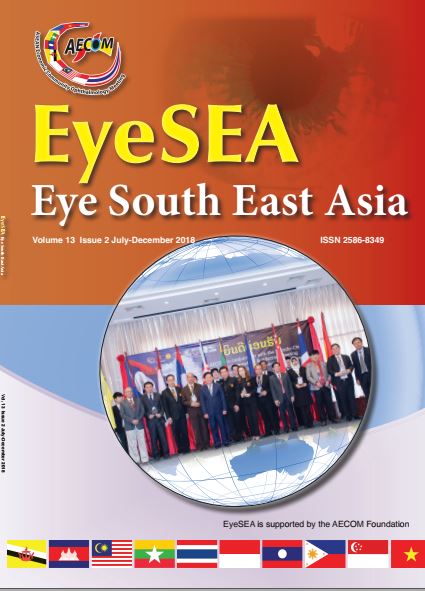Ipsilateral white cataract following percutaneous nephrolithotomy
Main Article Content
Abstract
Background: There is a rising concern over the increasing amount of radiation exposure
in patients undergoing diagnostic imaging and medical procedures. A case of rapid visual
deterioration following a percutaneous nephrolithotomy (PCNL) has been described. The
aim of this paper is to report the formation of semi-acute white cataract following a PCNL
procedure.
Methods: Case Report
Results: A 57-year-old gentleman with underlying hypertension, gout and history of right
nephrolithiasis complained of rapid deterioration in his right eye (RE) vision for 3 months
duration. It was not associated with eye pain, redness, eye discharge or history of eye
trauma. He denied taking steroids or any over-the-counter medication. However, prior to
that he underwent a PCNL procedure for right nephrolithiasis. His visual acuity was 6/60
for the affected eye. Anterior segment examination reveals dense white cataract on the RE
which turned out to be dense cortical matter following phacoemulsifcation.
Conclusion: Although uncommon and not routinely discussed between surgeons and
patients, PCNL may cause a semi-acute cataract formation secondary to radiation associated with the procedure. In view of the increasing trend of radiation involved in the
management of nephrolithiasis, both surgeons and patients need to be made aware of this
complication and the possible ways to overcome it.
Conflicts of interest: The authors report no conflicts of interest.
Article Details
References
2.Romero V, Akpinar H, Assimos DG. Kidney stones: a global picture of prevalence, incidence and associated risk factors. Rev Urol 2010 Spring;12(2):e86-96.
3.Malik I, Wadhwa R. Percutaneous Nephrolithotomy: Current Clinical Opinions and Anesthesiologists Perspective. Anesthesiology Research and Practice 2016;1:1-7.
4.Kim KP, Miller DL, Berrington de Gonzalez A, Balter S, Kleinerman RA, Ostroumova E, et al. Occupational radiation doses to operators performing fluoroscopically-guided procedures. Health Phys 2012;103(1):80-99.
5.Mancini JG, Raymundo EM, Lipkin M. Factors Affecting Patient Radiation Exposure During Percutaneous Nephrolithotomy. J Urol 2010;184(6):2373-7.
6.Nahas AE, Shokeir AA, Shoma A. Percutaneous nephrolithotomy versus open surgery for treatment of staghorn stones in pediatric patients. Can Urol Assoc J 2014;8(11):906-9.
7.Celik H, Tasdemir C, Altintas R. An overview of percutaneous nephrolithotomy. EMJ Urol 2015;1:46-52.
8.Lipkin ME, Preminger GM. Risk reduction strategy for radiation exposure during percutaneous nephrolithotomy. Curr Opin Urol 2012;22(2):139-43.
9.Taylor E, Miller J, Chi T, Stoller ML. Complications associated with percutaneous nephrolithotomy. Transl Androl Urol
2012;1(4):223-8.
10.Chen TT, Wang C, Ferrandino MN. Radiation exposure during the Evaluation and Management of Nephrolithiasis. J Urol 2015;194(4):878-85.
11.John BS, Patel U, Anson K. What radiation exposure can a patient expect during a single stone episode? J Endourol
2008;22(3):419-22.
12.Boal TJ, Pinak M. Dose limits to the lens of the eye: International Basic Safety Standards and related guidance. Ann ICRP 2015;44(1):112-7.
13.Elkoushy MA, Andonian S. Lifetime Radiation Exposure in Patients with Recurrent Nephrolithiasis. Curr Urol Rep
2017;18(11):85.
14.Lipman RM, Tripathi BJ, Tripathi RC. Cataracts induced by microwave and ionizing radiation. Surv Ophthalmol
1988;33(3):200-10.
15.Shore RE, Neriishi K, Nakashima E. Epidemiological studies of cataract risk at low to moderate radiation doses: (Not) seeing is believing. Radiat Res 2010;174(6):889-94.
16.Vano E, Kleiman NJ, Duran A. Radiation cataract risk in interventional cardiology personnel. Radiat Res 2010;174(4):490-5.

